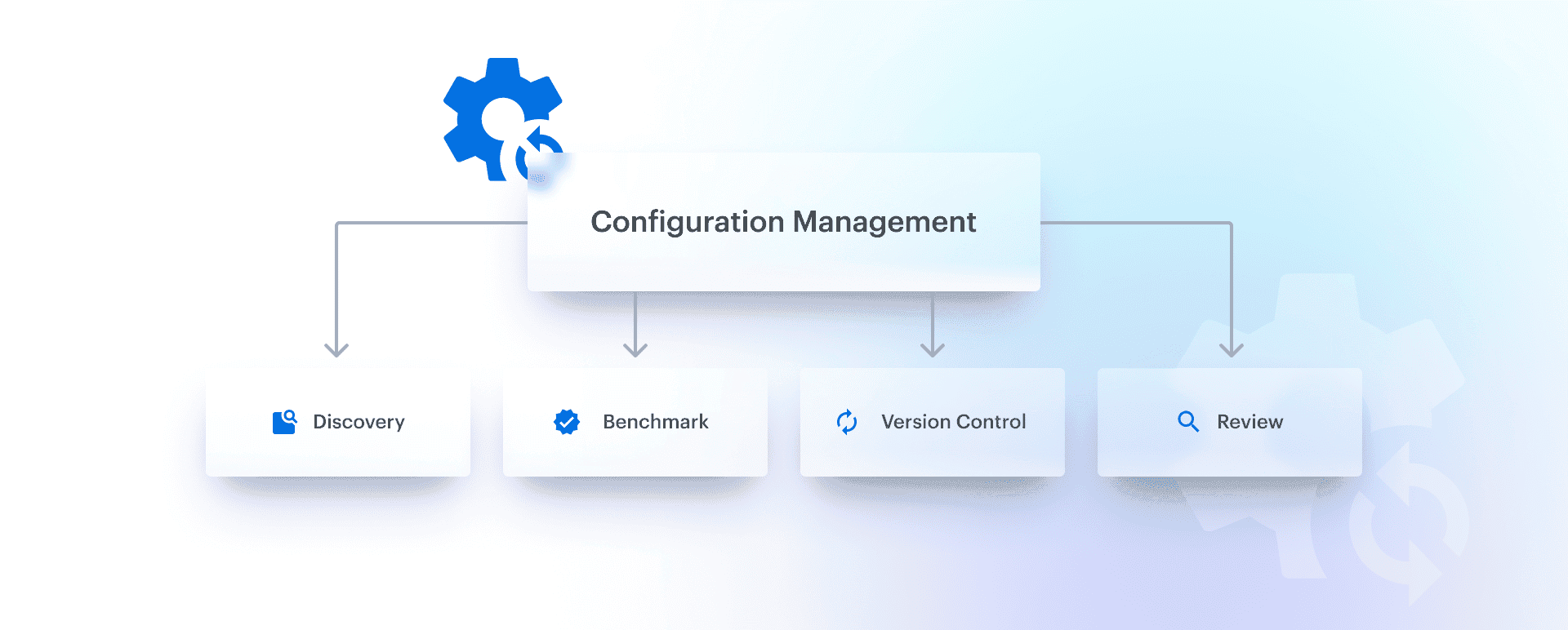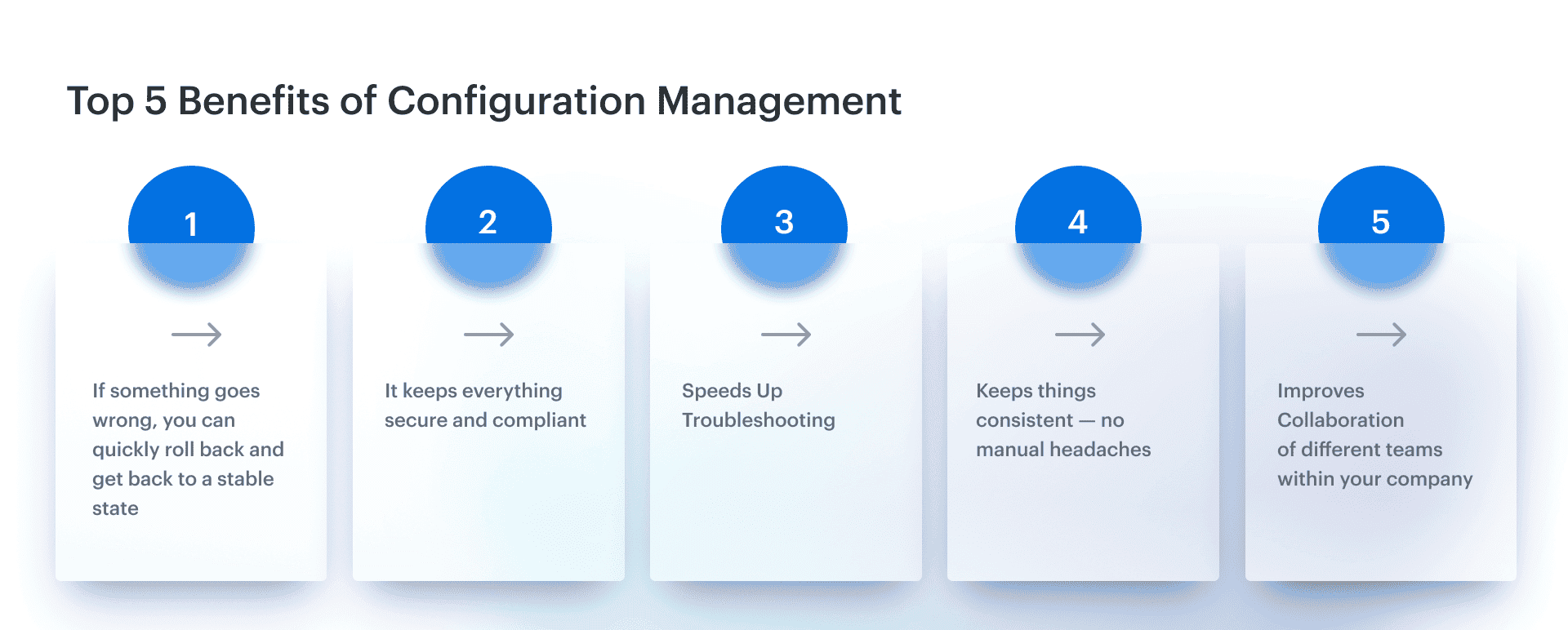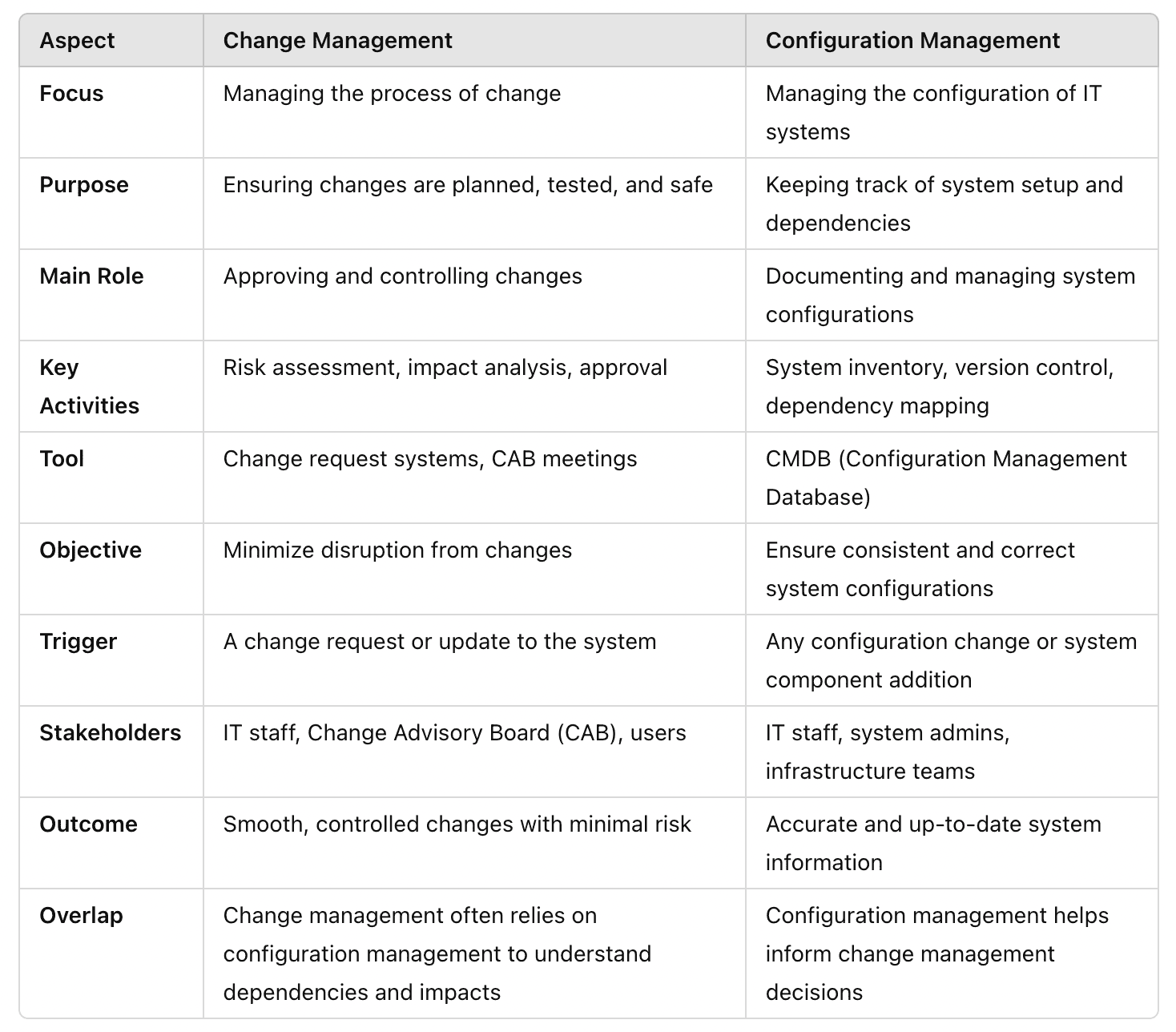You know that sinking feeling when something breaks in prod and nobody knows if it was a rogue change, a misconfigured resource, or just Monday being Monday? That’s exactly when the whole configuration management vs change management thing stops being theory and starts being survival.
We’ve all been there. Scraping through logs. Chasing phantom updates. Trying to piece together what changed, when, and why. And honestly? That’s the moment you realize how critical it is to have solid configuration management in place. Backed by change management that isn’t just a checkbox process but actually built into how your cloud moves.
In this one, we’re diving into the real deal. A straight-up comparison of configuration management vs change management. How each one holds its own. And — more importantly — how they work together to keep your cloud estate sane. Think of it as the tag-team your infra didn’t know it desperately needed.
What is configuration management?
Configuration management is your system of record for “what’s what” in your environment — every asset, every dependency, every setting, and every version, tracked in real-time or close enough to it.
It’s not just about inventory; it’s about knowing the desired state of your infrastructure and having the receipts to prove it.
You want to know if an EC2 was spun up with the right AMI, if a firewall rule matches policy, or if some VM in the corner of your estate is still rocking a legacy config from three months ago?
That’s configuration management doing its thing.
It’s the foundation layer that lets change management make smart decisions. No guesses, no tribal knowledge. Just source-of-truth clarity across clouds, tools, and teams.
5 components of configuration management
Configuration management is just “keeping track of stuff.” But when you're managing a tangled web of services, tools, and platforms across environments, it’s way more than that. There’s a rhythm to doing it right — a set of core elements that show up in every solid config management process I’ve seen in the wild.
Here’s what that backbone usually looks like:

- Identification. First step: name it to tame it. Every resource, system, and component gets uniquely identified. If it exists, it’s tagged and tracked — no mystery assets sneaking around.
- Baseline. Then we define what “normal” looks like. Approved configurations, golden images, secure defaults. This is your foundation for spotting drift later on.
- Control. Here’s where we manage the madness. Changes go through checks — automated or manual — to make sure nothing gets rolled out without a green light.
- Status Monitoring. This is the watchdog phase. We constantly check current states against baselines, catching misalignments early before they trigger alerts in the middle of the night.
- Audit & Reporting. And of course, we log everything. Because the question isn’t if someone’s going to ask who changed what — it’s when.
Now, let's see configuration management in action 👇
Speaking about configuration management vs change management comparison, I have a great example from one of our clients - a Coca Cola giant.
This company is juggling AWS, Azure, and an on-prem VMware beast. Their CISOs were breathing down ops' necks about asset visibility, the ITAM lead was swimming in outdated CMDB exports, and nobody could answer a simple “what do we own?” without starting a war room.
This wasn’t about some isolated change — it was a full-blown compliance management fire drill. And the real issue? Their configuration management system had gaps wide enough for shadow IT to waltz through unnoticed.
They kicked things off with automated discovery across their environments — Lambda functions, SQL clusters, ghosted GCP VMs no one admitted to. Every asset got tagged by environment, owner, business unit, even patch window. Not just EC2s — network interfaces, attached volumes, AMI lineage, legacy security groups — everything was fair game.

That tagging logic? It fed the entire management system — compliance dashboards, policy enforcement, cost controls. This wasn’t just change management. This was about proving, at any moment, that they were in control. Config became the audit-proof spine of their cloud ops. Quietly powerful. Absolutely necessary.
5 advantages to expect after its implementation
When you're juggling change requests, compliance checks, and surprise asset discoveries before your second coffee, the difference between configuration management vs change management starts to really matter. One sets the rules. The other shows what’s actually happening out there.
To cut through the noise, I asked a few of our teammates to share how configuration management shows up in real life:

Total Visibility = No More Ghost Assets
Anna, ITAM expert at Cloudaware:
“Without config management, we’re basically doing CMDB karaoke — pretending we know what’s deployed where. Once we got automated discovery running and tags dialed in, it was like someone turned the lights on. We stopped guessing. No more ‘mystery resources’ racking up costs or violating policies. Everything from our EKS clusters to that one ancient Windows server had an owner, a purpose, and a paper trail.
Gartner actually pegs 30% of cloud spend as wasted due to lack of visibility and governance. That was us — until config flipped the switch.”
Compliance Without Panic Mode
Kristina S., Senior Technical Account Manager at Cloudaware:
“It’s the only way I can get audit-ready without waking up in a cold sweat. We’ve got multiple frameworks to answer to — CIS, NIST, SOC 2 — and config management gives us the real-time state we need to prove compliance.
No last-minute spreadsheet scrambles.
No gaps.
Just clean, traceable data that maps straight to control objectives. IBM says mature compliance programs save $1.5M per breach on average. Honestly? That number tracks. Config management is our compliance safety net.”
Truth Over Assumptions in Incident Response
Iurii Khokhriakov, Technical Account Manager:
“It’s our reality layer. Change management tells you what should have happened. Config tells you what did. We had an incident last month where the runbook said the change was rolled back. But config data showed drift on two AZs. That insight shaved hours off our response time and made sure we fixed the actual issue instead of chasing ghosts.
And honestly, with 87% of orgs dealing with misconfigs in the cloud, we’re not alone. Config data is what cuts through the noise.”
With clear configuration management, you’re in the driver’s seat. It’s the foundation for smooth operations, smarter change management, and a resilient IT setup.
Read also: The best configuration management software: Top 10 tools review
What is change management?
Alright, so config management tells you what is. Change management? That’s all about what’s about to go down — ideally in a way that doesn’t break half your infra or summon your CISO at 2 a.m.
At its core, change management is the process that governs how modifications — big or small — get introduced into your environment. We're talking everything from updating IAM policies and tweaking a firewall rule, to rolling out a whole new deployment pipeline.
It’s the system that says, “Hold up, let’s think this through,” before anything touches prod. Especially in configuration change management, where even a single misstep can cause drift across environments, getting it right is mission-critical.
5 components of change management process
It usually kicks off with a request (standard, normal, or emergency), moves through impact assessments, loops in approvals from the right folks — security, platform, app owners — and ends with clean implementation, post-change validation, and solid documentation.

- Change Requests: The starting point. Someone proposes a change — maybe an update, a new feature, or retiring a legacy system.
- Impact Analysis: Assessing risks. Will this change disrupt the ERP? Break the CRM? Cost a fortune?
- Approval Workflow: Enter the Change Advisory Board (CAB). They approve or deny requests based on impact and necessity.
- Implementation Plan: Detailed steps for rolling out the change while keeping disruptions minimal.
- Review and Closure: Post-change review to ensure success and document lessons learned.
Real-world example of change tracking in action
Imagine a financial services company juggling AWS, Google Cloud, and a couple of on-premise systems. One day, they needed to update their online banking app — just a small tweak to improve login security. Simple, right? Not quite.
Without change management, the tweak disabled a critical on-premise reporting system. Users flooded support, and execs panicked.
With change management, they documented the proposed change. They analyzed its impact and found that the update's code interacted with the reporting tool. Instead of disaster, they adjusted the rollout. The result? Zero downtime, happy customers, and a customer advisory board (CAB) meeting filled with high-fives (well, maybe emails saying “Good job!”).
Top 5 benefits of change management
Why does it matter? Here’s why:

- Risk Reduction: Avoid breaking something critical when updating a system.
- Transparency: Every change is tracked and approved — no more surprises.
- Consistency: Standardized processes mean smoother rollouts and fewer errors.
- Collaboration: Everyone involved, from IT to business teams, stays aligned.
- Business Continuity: Systems stay reliable, even during big transformations.
With change management, your hybrid infrastructure stays flexible without falling apart. It’s about doing more with less chaos — because who has time for firefighting every time there’s an update?
Read also: Top 7 CMDB best practices for your 2025 [Tech Expert Review]
Differences between change management vs. configuration management
let’s break down configuration management vs change management the way we actually live it — not the way some dry ITIL manual would.
Because when you’re wrangling cloud, on-prem, shadow IT, and ten different audit frameworks, knowing the difference isn't optional. It’s how you stay sane and out of the post-incident review spotlight.
Here’s how it really plays out:

🔥 Purpose: Control vs. Knowledge (aka “Are we allowed?” vs. “What the heck do we have?”)
Change management focuses on the process of introducing changes safely and predictably.
It’s the bouncer at the club door. Nothing new gets deployed — whether it’s a new VPC peering connection, a database schema update, or a simple ALB rule tweak — without getting patted down, questioned, and cleared under strict change control.
Configuration management focuses on maintaining accurate records of the current state of infrastructure and services.
It’s the club map and guest list. It knows who’s inside, what they’re doing, and whether they’re still following house rules. It’s your knowledge base of every resource, relationship, and configuration that exists right now. Without it, change management is flying blind.
🔍 Scope: What’s About to Change vs. What Exists Right Now
Change management is all about what’s planned.
You’re handling structured changes: an engineer upgrading EKS versions, security rotating KMS keys, or devs requesting a new API Gateway deployment. Change requests are filed, assessed, approved, and slotted into maintenance windows under change control workflows in the management system.
Configuration management lives in the right-now.
It tracks that rogue Redis instance spun up for "temporary testing" six months ago. It flags that Azure SQL database missing firewall rules after a rushed migration. It watches for drift in real time, spotting unauthorized config differences that would wreck a PCI DSS or CIS audit if they went unnoticed.
📋 Records: RFCs vs. CIs (aka “Change Proposals” vs. “Proof of Existence”)
In change management, you’re creating RFCs — Requests for Change.
Each RFC documents intent: why a change is needed, what the risk is, who approves it, and how you plan to roll back if it fails. It's your auditable log that change processes were followed properly.
In configuration management, you’re building your system of truth with CIs.
Every resource, every relationship, every setting is tracked and timestamped. Accurate CIs aren't a nice-to-have — they’re critical to passing audits like CIS Controls v8 (Control 1.4: Maintain Detailed Asset Inventory).
Without them, your IT asset management turns into expensive guesswork.
🛠 Processes: Workflow Engines vs. Discovery Engines
Running change management is like choreographing a giant ops ballet.
You’re orchestrating approvals, scheduling deployments, validating change windows. CMDB tools like Cloudaware Change Management, Jira Service Management, or BMC Helix enforce the flow and make sure risky changes get the right scrutiny.
Configuration management is the always-on detective in the background.
Cloudaware, AWS Config, and Azure Resource Graph crawl your environment continuously. They discover assets, tag them, track their drift, and map their relationships. This isn’t a quarterly "asset refresh project" — it’s live telemetry for your management system that catches configuration changes the second they happen.
🚨 Impact of Failing: Governance Gaps vs. Visibility Gaps
Screw up change management and you end up with governance black holes.
Unauthorized changes slip through. Regulatory compliance blows up. You end up explaining to your CISO why a production S3 bucket got exposed without an approved RFC — violating frameworks like ISO 27001 A.12.1.2 (Change Management).
Screw up configuration management and you’re flying blind.
You’ll miss zombie resources eating your AWS budget. You'll leave open ports no one sees until a penetration test nails you. You’ll fail PCI DSS 11.2.1 (Asset Discovery) because your CMDB doesn’t reflect reality anymore.
Both failures hurt — but in different ways.
Configuration management vs change management isn't about picking one — it’s about making sure both processes are rock solid and tied together by a smart management system.
Change management and configuration management are two sides of keeping your environment sane.
Mikhail Malamud, Cloudaware GM:
It’s how you keep your CMDB trustworthy, your compliance intact, and your operations actually manageable — especially when you’re scaling across clouds, accounts, and frameworks. Ignore either side, and it’s not a question of if you’ll feel it — it’s when.
Where change management and configuration management overlap
Alright, here’s the scoop: change management and configuration management — two sides of the same coin, right? One keeps your systems stable. The other makes sure they don’t explode when you change something.
Where do they overlap? Oh, that’s where things get... spicy.
Let’s take a retailer as an example. They had a *beautiful* mess. AWS ran the shiny, customer-facing apps. An old on-prem database held the inventory. Azure handled analytics.
Smooth sailing? Not exactly. Change one thing, and who knows what’s going to break.
Enter the company manager. Cool as a cucumber, he sets up a CMDB — yeah, that’s configuration management’s secret weapon. Now, he can see everything. Every dependency, every connection, every tiny thread holding this monster together. It’s like Google Maps for your IT infrastructure.
The update to the order system? Easy. Or so it seemed. But then, bam — the risk appeared. The inventory system could go down if they weren’t careful. That’s where the change management kicks in. The manager runs an automated impact analysis. It’s like setting your alarm before you run across the street — just to be safe. The solution? Tweak a setting, and boom, all good.
The plan goes to the CAB. Fast approval — click, done.
The result?
Zero downtime. Smooth rollout. No inventory chaos. Just a perfect dance. Configuration management set the stage, and change management led the moves. Seriously, it was like watching professionals. But with a lot less jazz hands.
How Cloudaware can help you do both
Here’s the thing — when configuration management and change management live in silos, weird stuff happens. You get alerts that don’t line up with recent changes. Drift that sneaks in under the radar. Audit questions you thought you had answers to. That’s exactly why Cloudaware exists — to snap these two worlds together into a management system that actually makes sense.

Cloudaware unites configuration management and change management through a real-time, security-first CMDB that doesn’t just track assets — it understands them. It’s a system built for environments that never sit still, with discovery that updates in near real-time, not next week.
And when your compliance team’s breathing down your neck? You’ve got out-of-class security and complete audit trails to back you up.
Here’s what makes it tick for both change management and configuration management:
🔍 Continuous discovery (cloud + on-prem)
🏷️ Deep tagging logic with ownership, env, policy alignment
🧠 Relationship-aware CMDB with real-time configuration status
🛠️ Configuration change tracking tied to business context
✅ Policy & drift enforcement with approval hooks
🧾 Full audit history of every configuration and change
🚨 Integrations with ITSM, SIEM, and native cloud tools for end-to-end management visibility
More useful links:
Diverse CMDB schema to manage cloud-native and hybrid infrastructure
